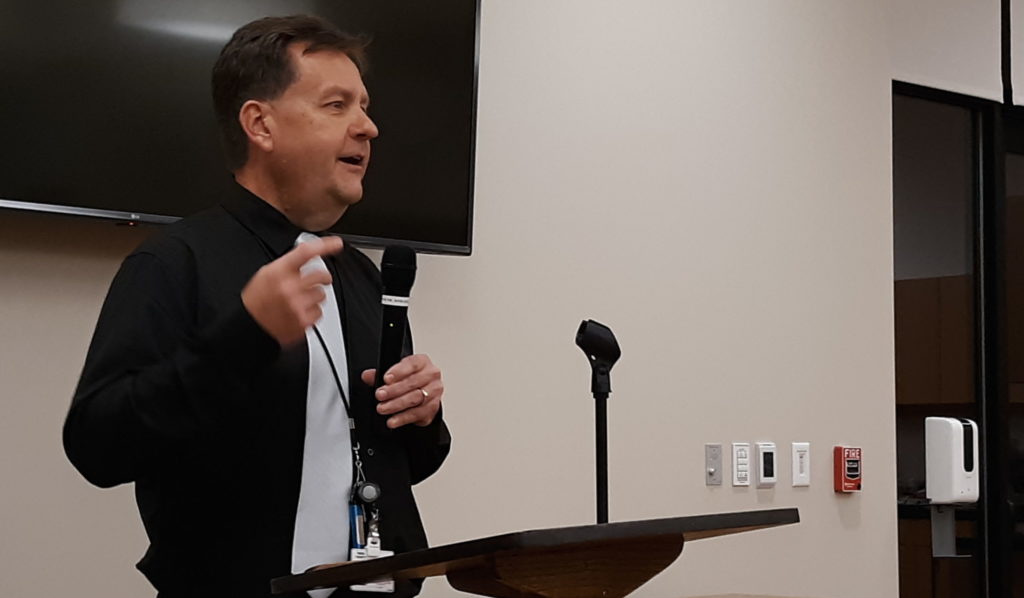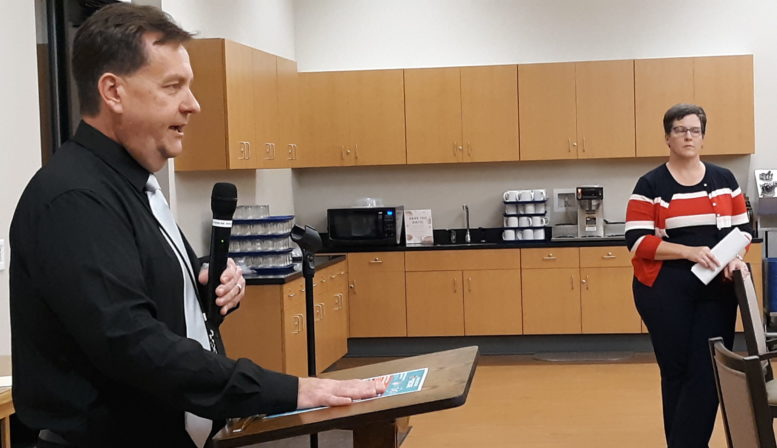By JAN LARSON McLAUGHLIN
BG Independent News
Wood County elections officials have complete confidence in the local voting system. They can cite safeguards, testing procedures and audits that show elections here are secure.
But they are very aware that since 2020, elections take place under a dark cloud of suspicion.
“As you know, the security of our elections is being questioned in some quarters,” Janet Parks, president of the Bowling Green League of Women Voters, said as she introduced Terry Burton and Julie Baumgardner, co-directors of the Wood County Board of Elections.
“It’s so important for us to understand how our elections are run,” Parks said as the league members gathered Tuesday to be educated about election security from those in charge of safeguarding it locally.
Burton and Baumgardner stressed that election results are accurate in Wood County.
“We know there are people out there who are doubting the process,” Burton said, adding that it’s unlikely he could say anything to convince some that the process is secure.
He told of inviting some “doubters” to the board of elections office to show them the hard paper copies of each ballot cast, and the voting machine security.
“All our machines are right in our office,” not stored offsite,” Burton explained to a man. And they are never plugged into the internet.
“The gentleman looked at me and said, ‘That’s not true,’” Burton recalled. He went on to explain the voting machines don’t have the technology needed to link into the internet. But again the man denied that the machines are safe.

Burton and Baumgardner explained that all Ohio elections are run locally and the process has integrity.
“It is personal for us,” Burton said.
“I’ve read about the horror stories in other states,” where election workers are threatened and bulletproof dividers have to be installed to separate the workers from the public. “Luckily, I can say that’s not the case here.”
Part of the civil election process here might be due to the courteous nature of Midwesterners.
“While we all have passions, we’re polite about it,” Burton said.
Also helping to quell criticism might be the bipartisan efforts of election boards in Ohio.
“We’re a Noah’s Ark office,” he said. Two people – one from the Democratic and one from the Republican parties – work together on voting processes. They work in pairs as they retrieve ballots from the drop-off box, as they test the voting equipment, as they work at polling places. And two members from each party serve on the board of directors.
“Each step we are bipartisan – that’s an Ohio thing,” Burton said. “We leave our politics at the door. We’ve got work to do.”
Burton, a Republican, and Baumgardner, a Democrat, talked about all the layers of security for elections.
- All voting equipment is certified. “These systems are put through the wringer at every level before they get to us,” Burton said.
- Homeland Security officials inspected the office a couple years ago, leading to more cameras, gates, etc.
- Local people test the 400 voting machines for accuracy before every election. “We’re ensuring our own democracy works,” Burton said.That testing process can take up to two weeks. “Every single one of those we have to test,” Baumgardner said.
- All ballots are programmed in the local office. “We have total control,” Baumgardner said.
- All other equipment, such as the 94 poll pads, must also be tested. “Every single piece of equipment we deploy, we test first,” Baumgardner said. “Any issue we find, we start all over and make sure it’s right.”
- A hard paper copy is printed for every ballot cast.
- A series of seals and locks are used to make sure no one tampers with the votes.
- Regular audits are performed after each election. Burton said he used to consider those “free recounts,” but they have lent credibility to the election process. The statewide results showed a 99.98% accuracy rate in the 2020 presidential election. “Ours was 100%, in case you’re curious,” he said.

League of Women Voters members also asked questions of the elections officials about early voting, online voting, poll volunteers, voter purges, campaign violations, and voter intimidation efforts.
Voters in Canada, France and Australia are able to vote online, one member said. Will that be happening anytime soon in the U.S.? Burton said he had thought online voting would occur during his lifetime – but now he’s not so sure. “We’ve taken a step back,” he said.
Mailed ballots and early voting became popular during COVID, Burton said, noting that about 300 voters cast their ballots on Tuesday.
“It takes some pressure off the polls,” he said.
Polling places are no longer packed at closing time (7:30 p.m.), but they are still busy early in the morning and at lunch time. “We just don’t see the lines that we used to,” Burton said. But he pointed out that anyone in line by 7:30 p.m. is not turned away from voting.
Yes, the board of elections still needs volunteers for this upcoming election.
“We are always looking for poll work volunteers,” Burton said. “We’re looking for people who want to help their community for good reasons.”
Burton also explained the “voter list maintenance” process of purging voters from the rolls who have had no contact with the board of elections in the past two federal elections. Those voters are sent confirmation cards, and are not purged as long as they send back the card.
If after two more federal elections, the voter still has not voted, has had no other contact with the board, or did not respond to another letter, they are then deleted from the rolls.
What are the rules for campaigning near a polling place? Burton explained no signs or people campaigning are permitted within 100 feet of a polling site.
“We always have people pushing that limit,” so poll workers are armed with tape measures, he said.
People wearing shirts, hats or buttons for a candidate or issue are asked to turn their shirts inside out, and remove their hats or buttons. Poll workers cannot keep those voters from casting ballots, Burton said.
Poll “observers” must be appointed by a political party, by a group of five or more candidates, or by an issue committee.
“A person who just announces they are an observer does not qualify,” he said. Poll workers must be made aware of “observers.”
“They are our frontline defense for security,” Burton said of poll workers.
Though some areas of the country are reporting efforts to intimidate voters at ballot drop-off boxes, Wood County has not experienced that, he said. Conversations have been held at the local and state level about how to handle such intimidation if it were to occur here.
“So far, no incidents,” Burton said, noting that the drop off box by the county building has a security camera.
Burton talked about the need for stability in the election process.
“Politics have been this ugly before,” he said. “But I hope it doesn’t stay this way.”
He is hoping Ohio doesn’t try to legislate its way out of election suspicions.
“While we all would like to fix things, I get a little nervous about the legislature trying to fix things,” Burton said.
Parks praised Burton and Baumgardner for “your sincere commitment to doing it right.”

